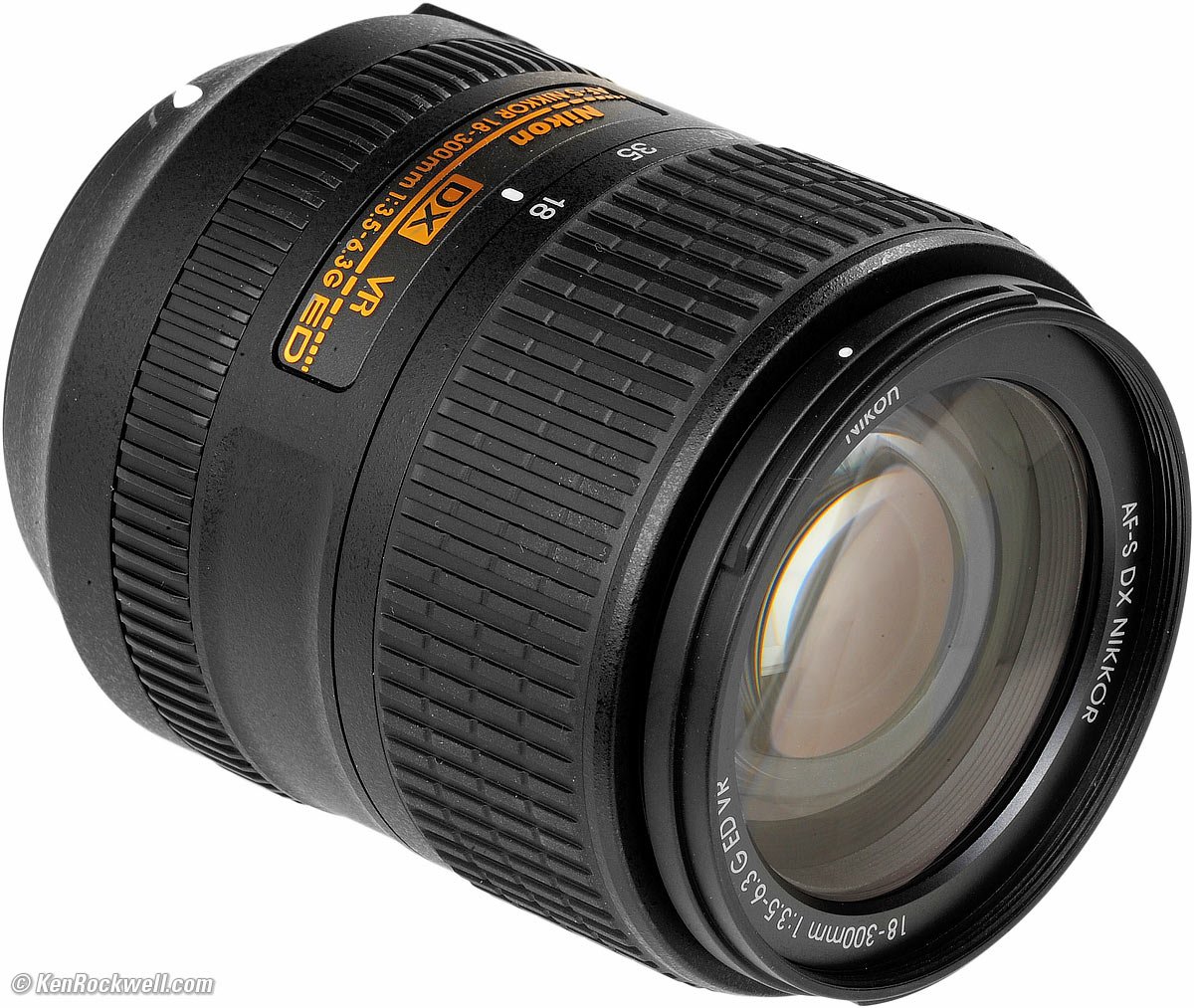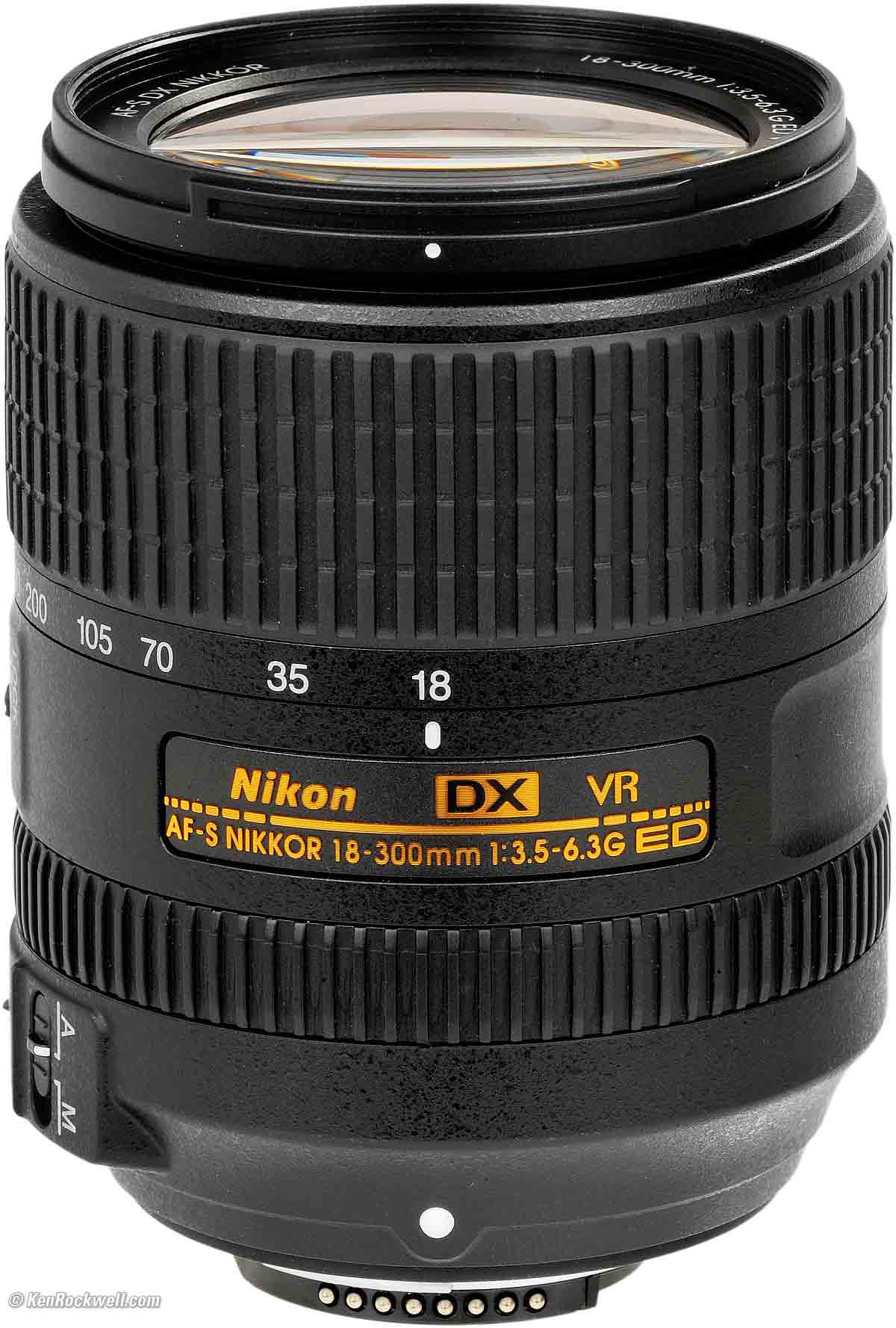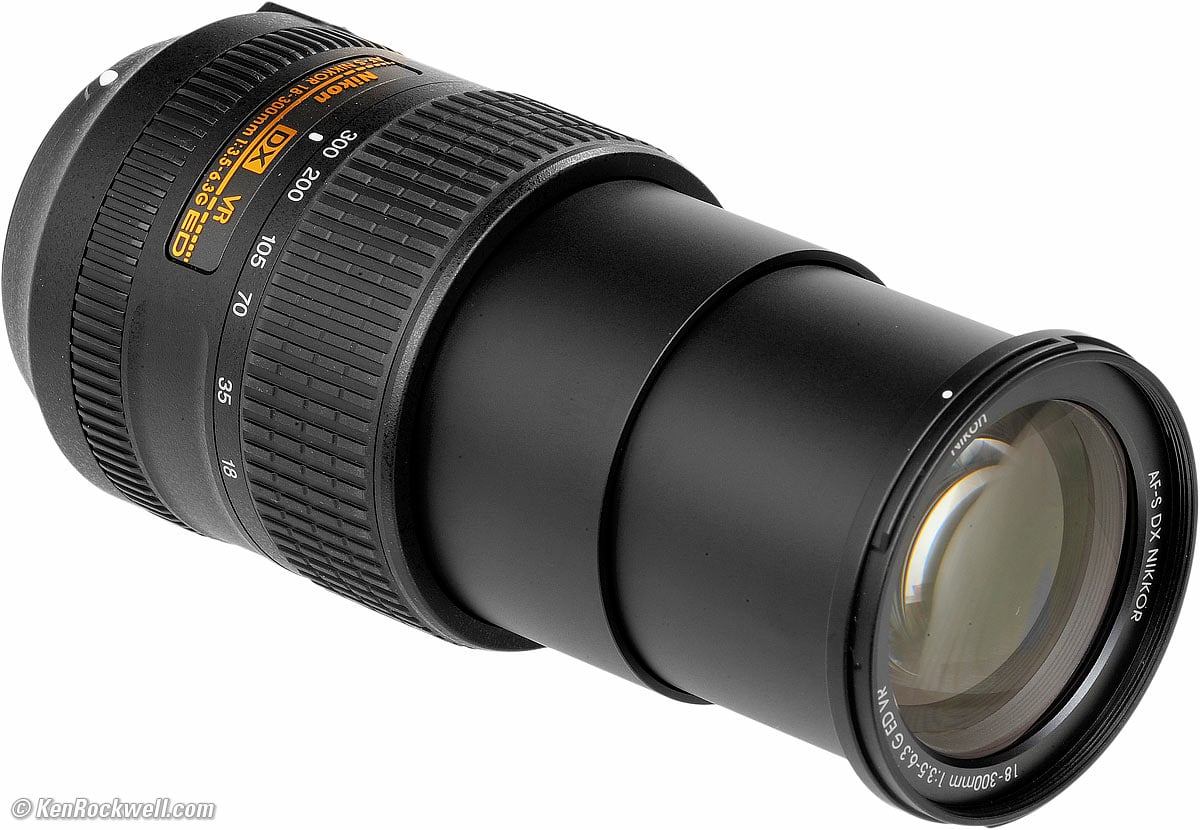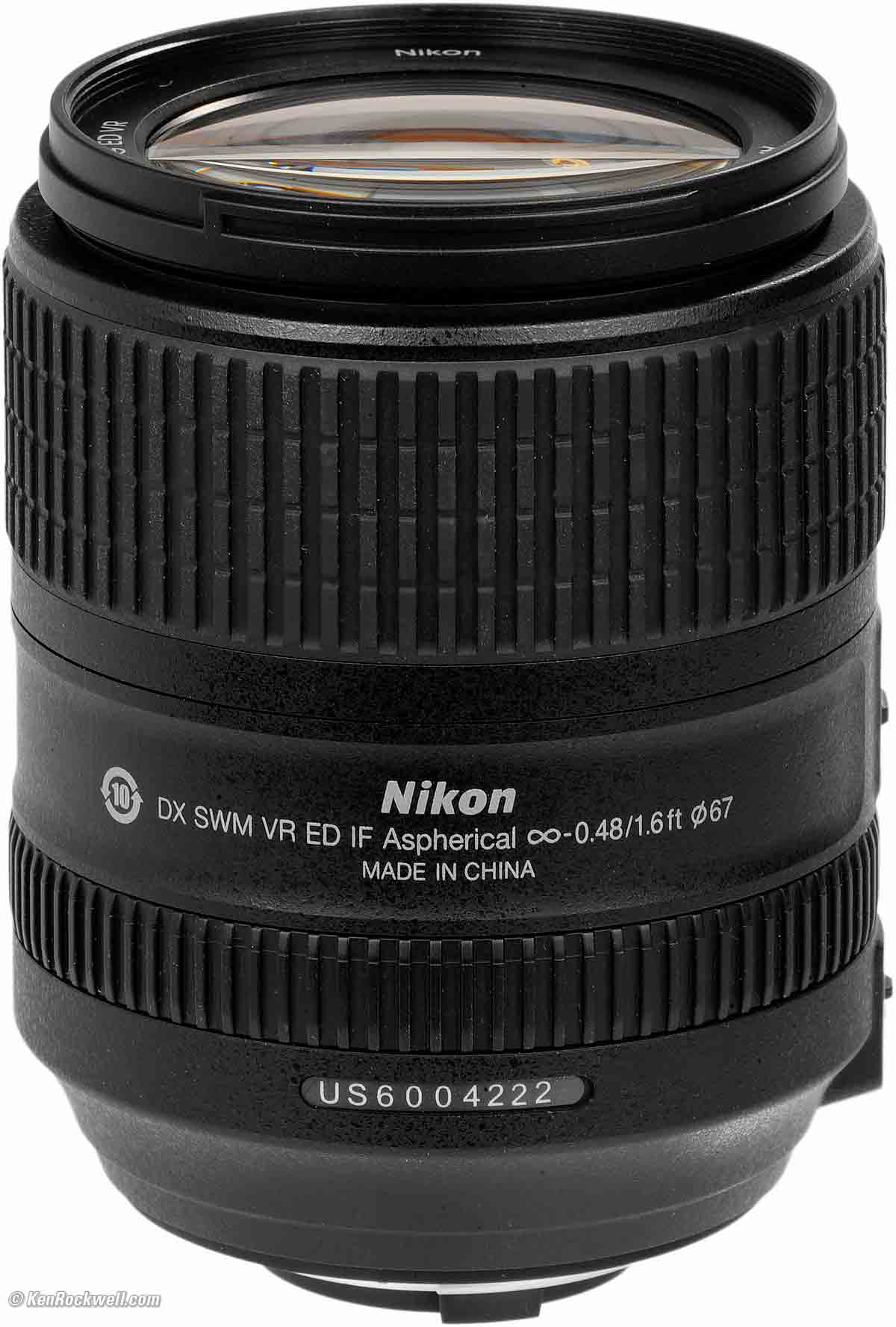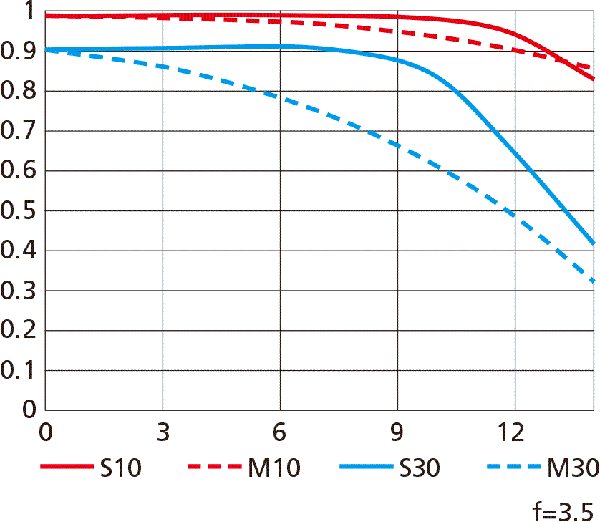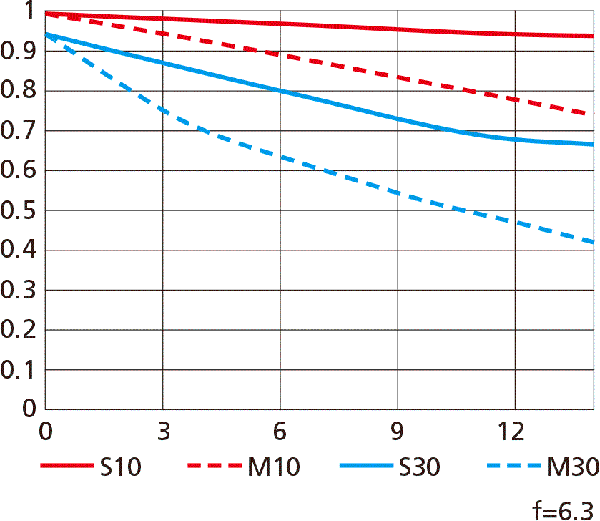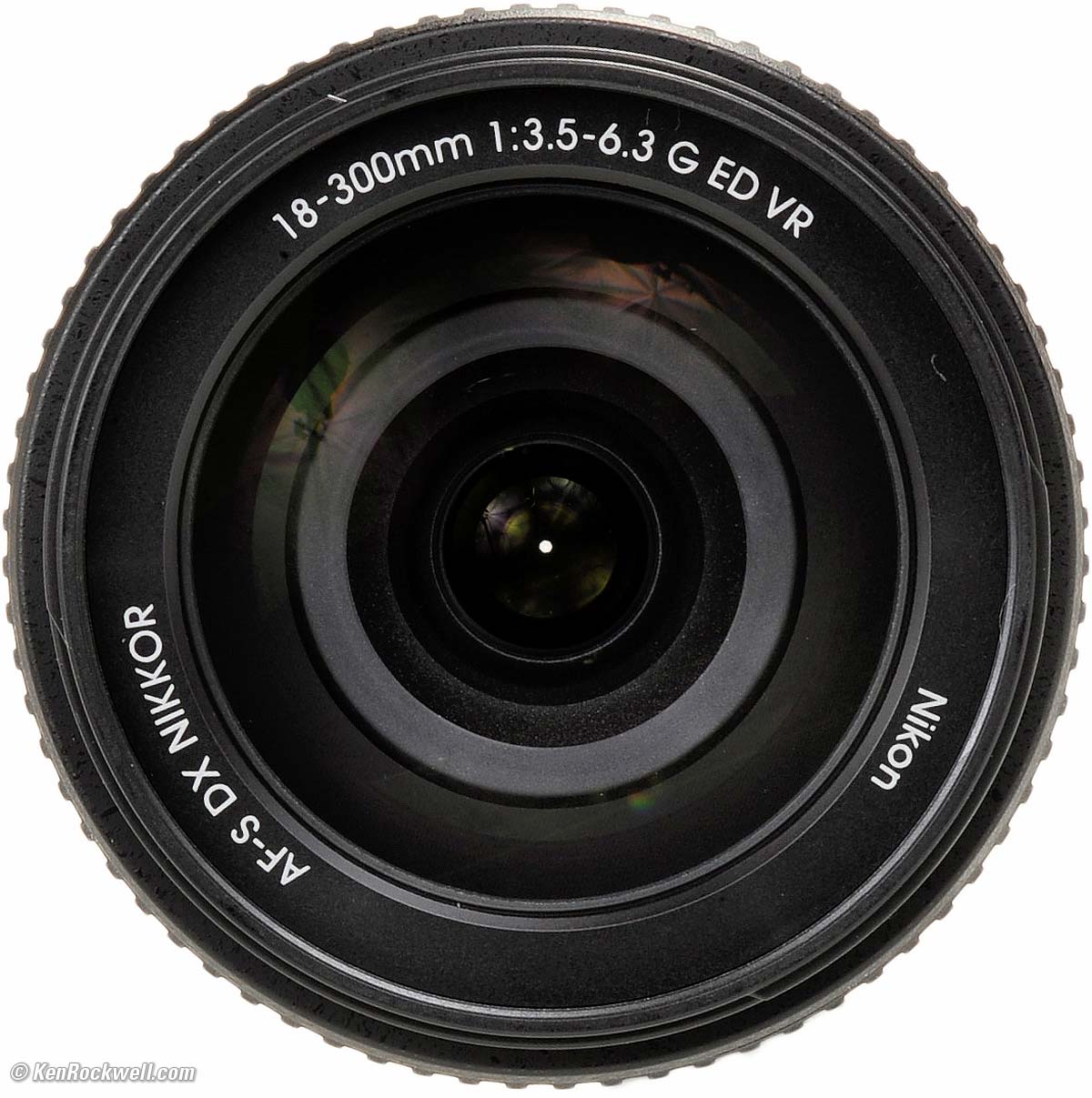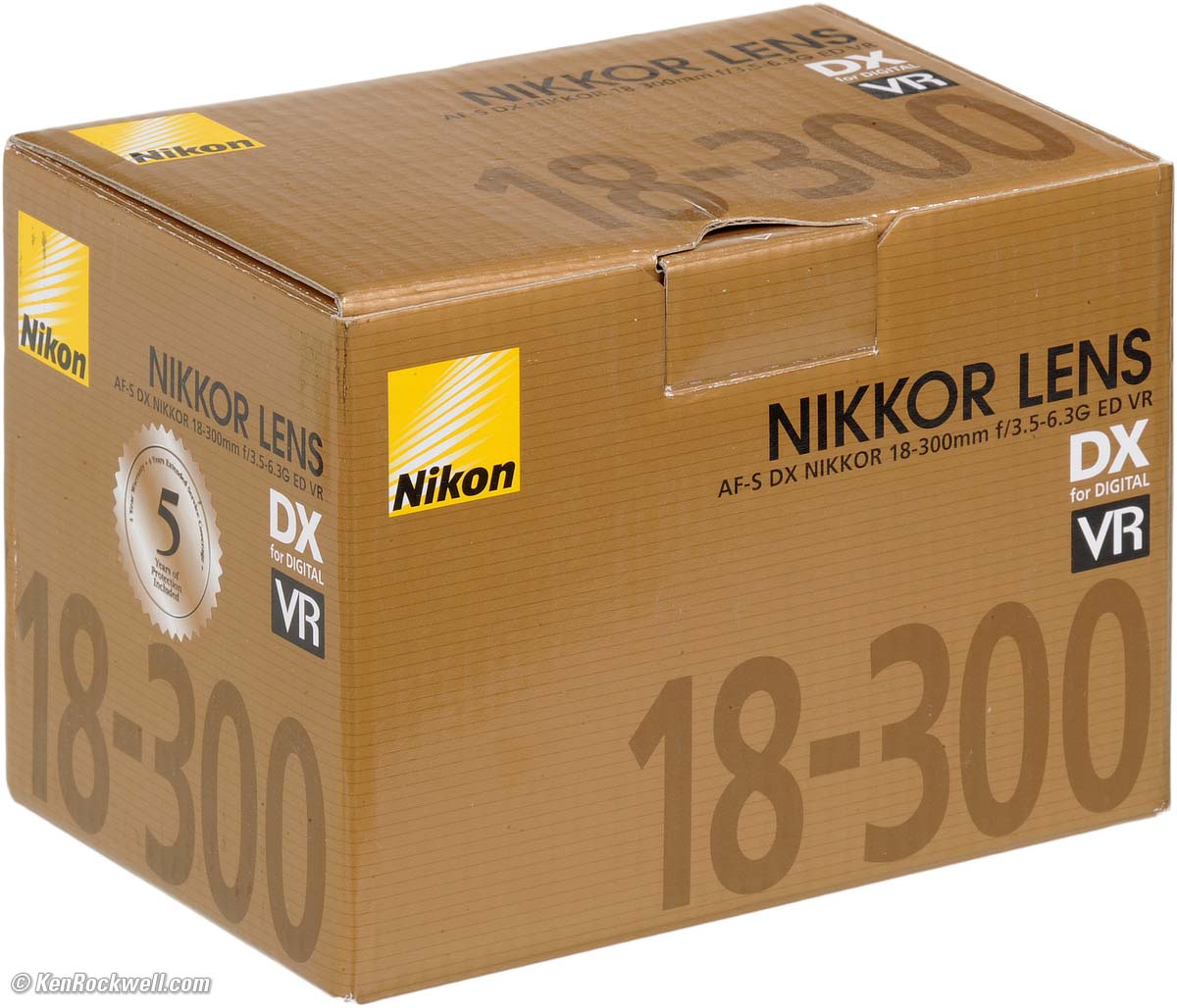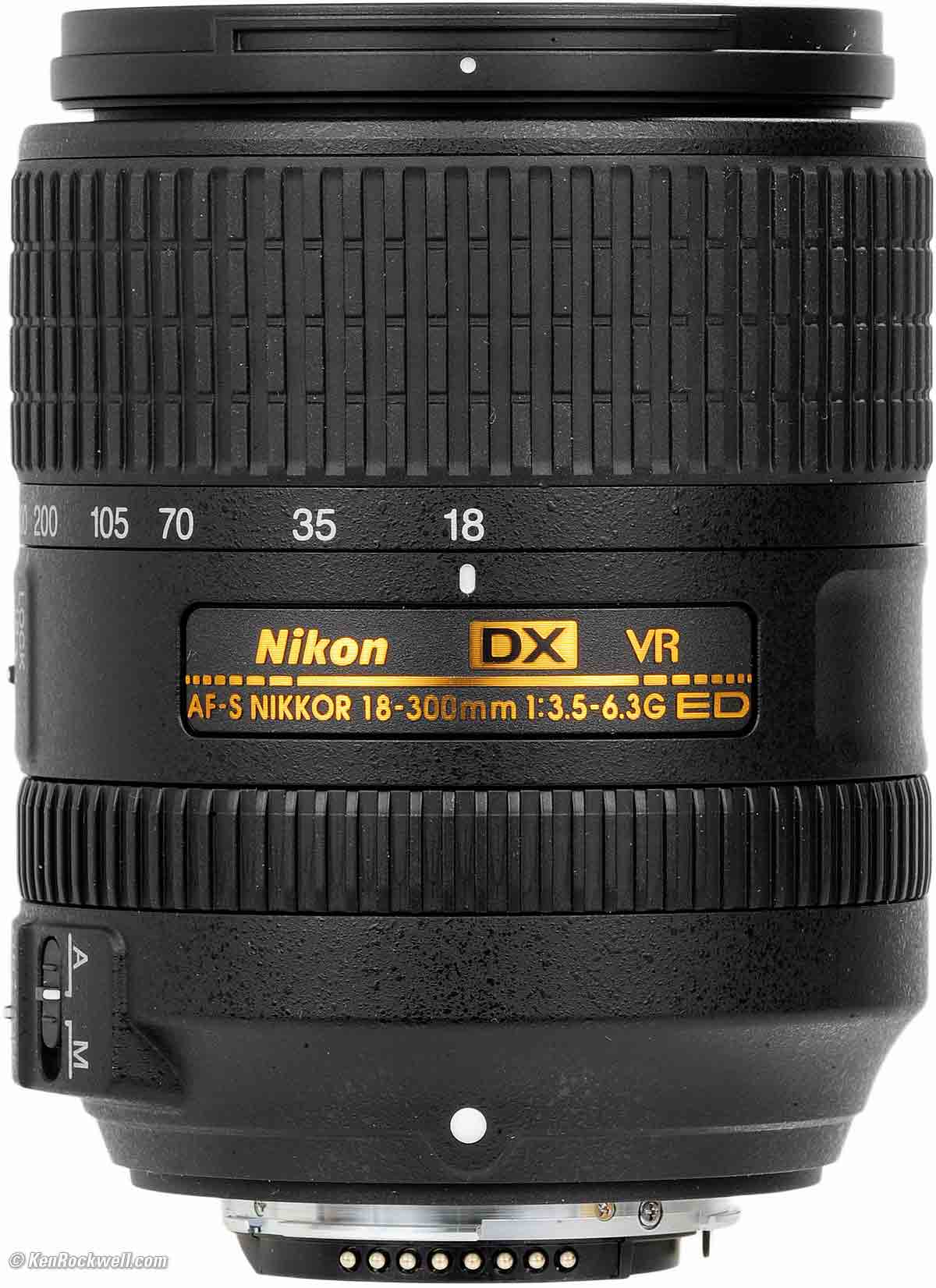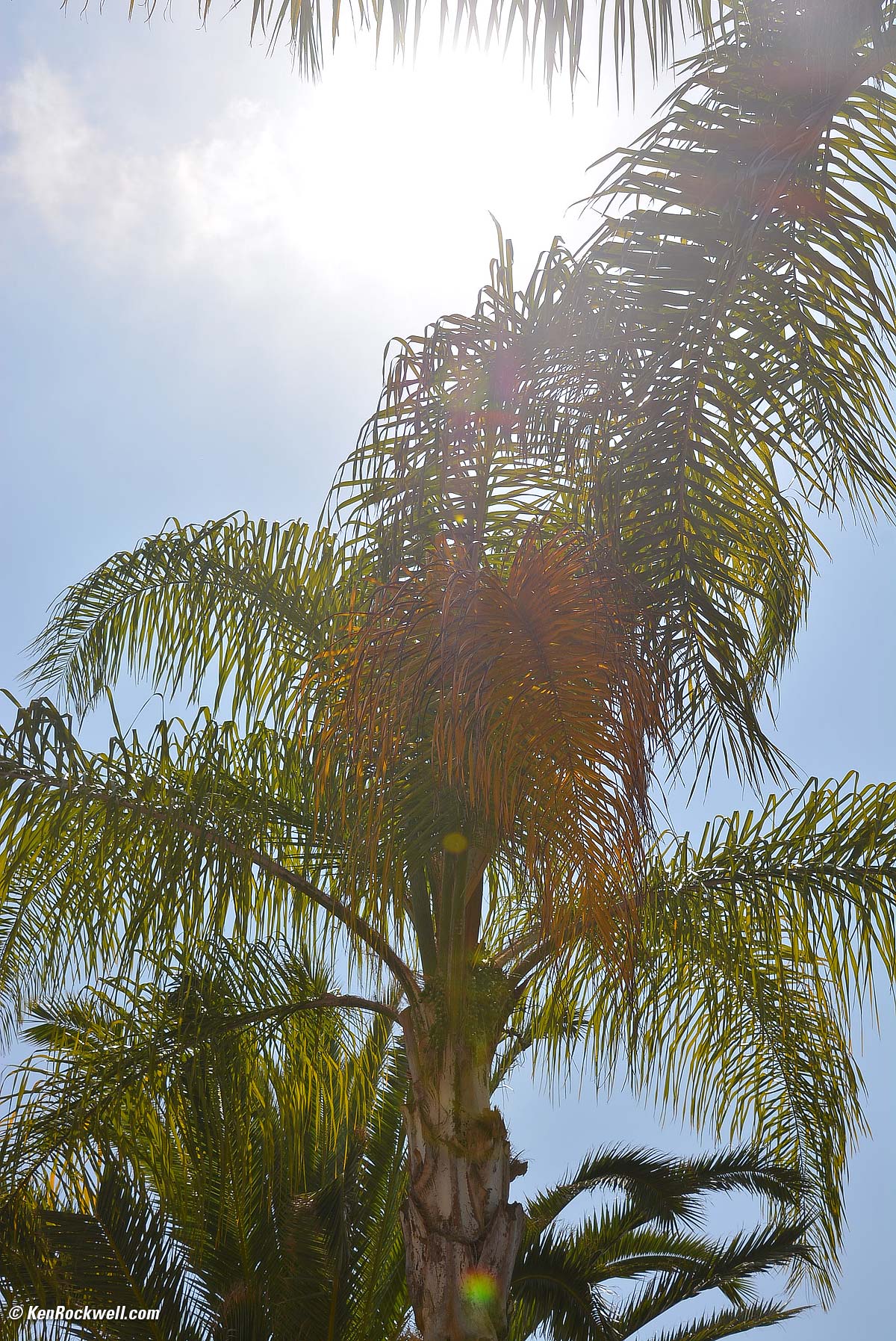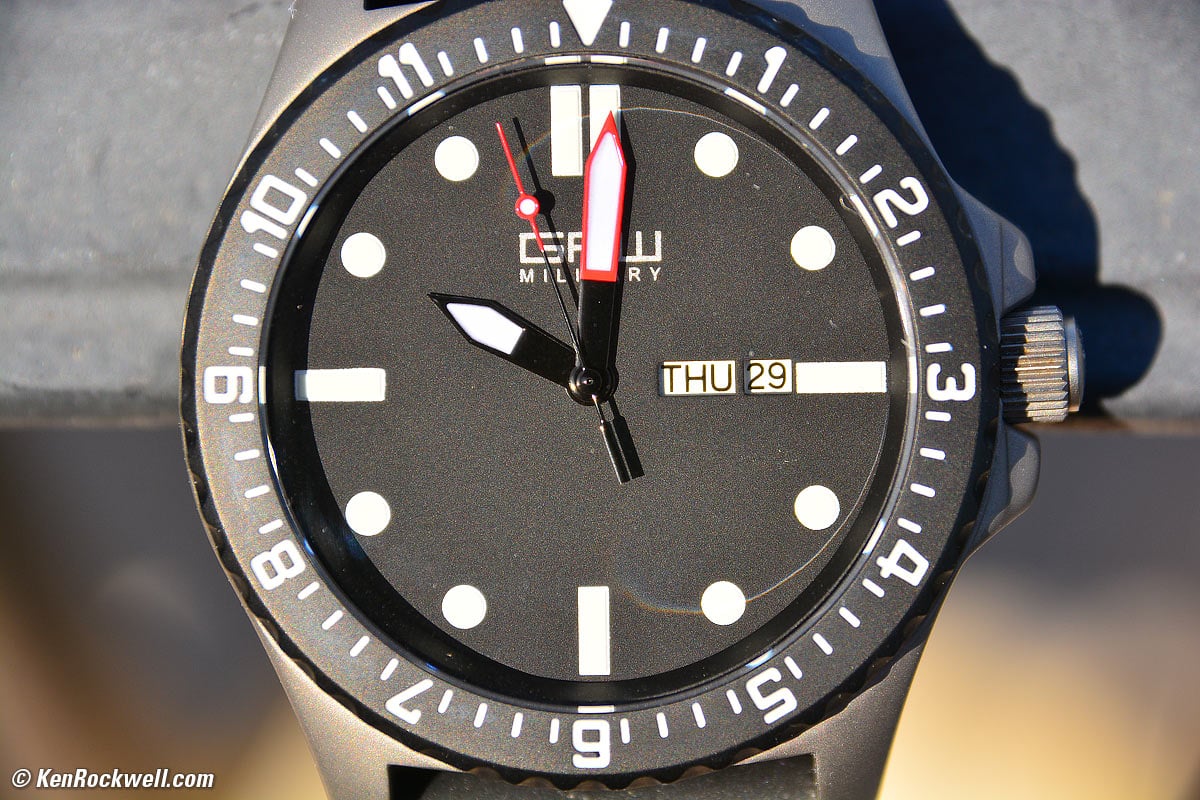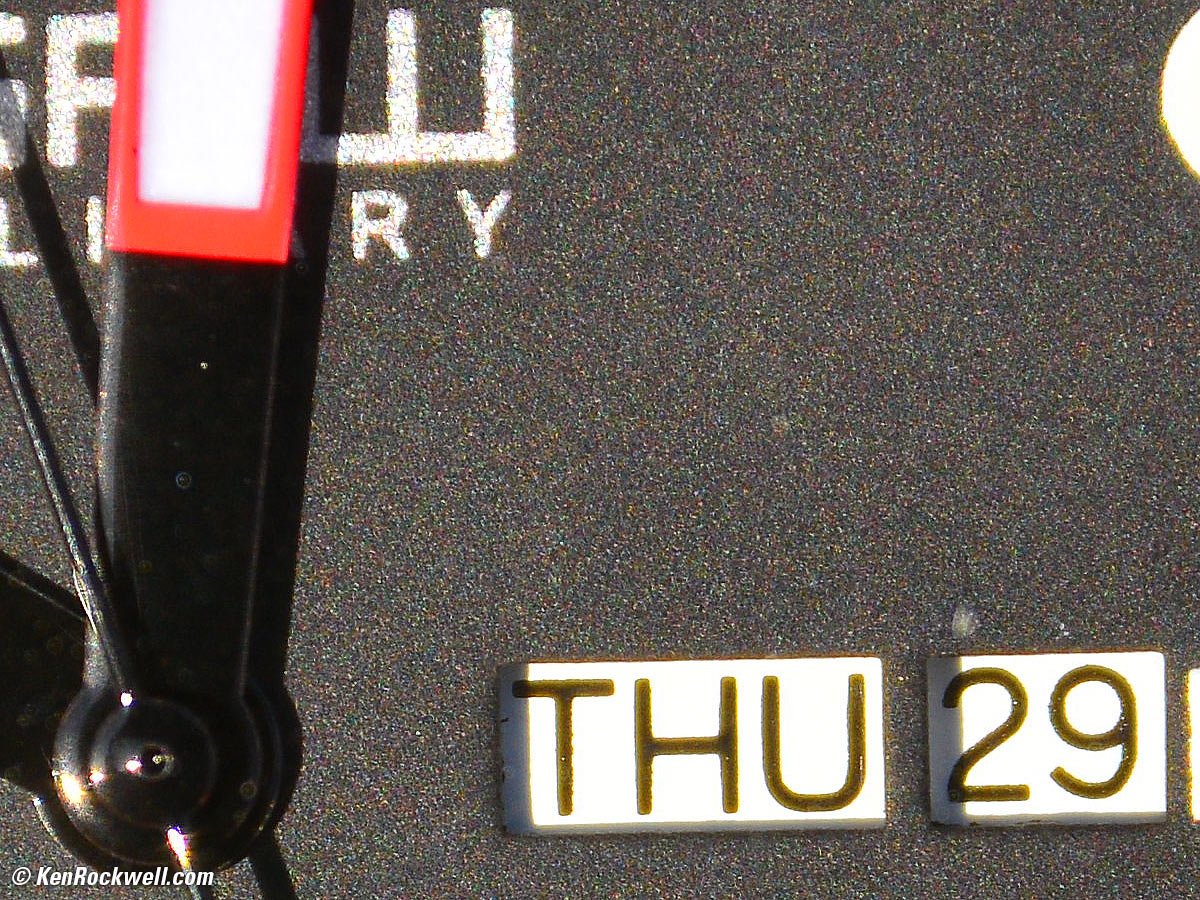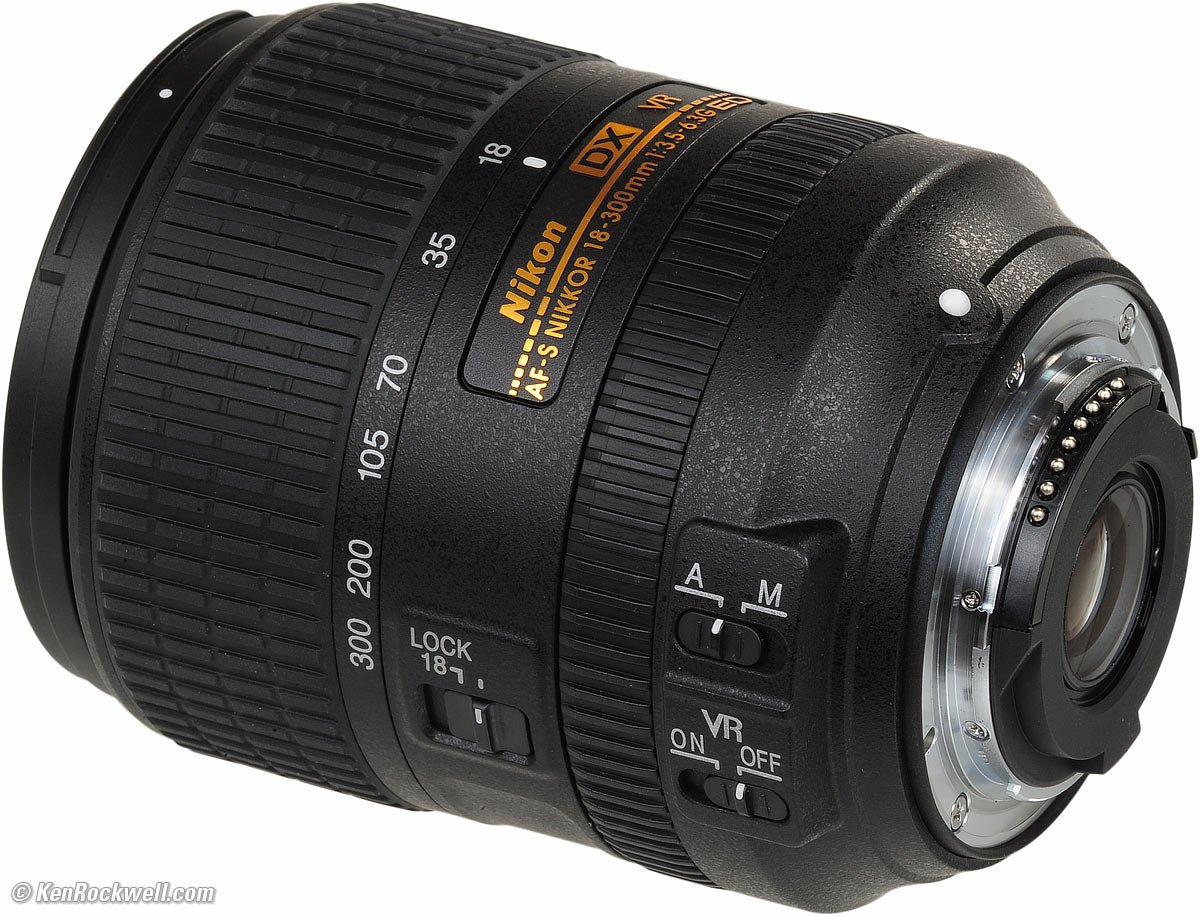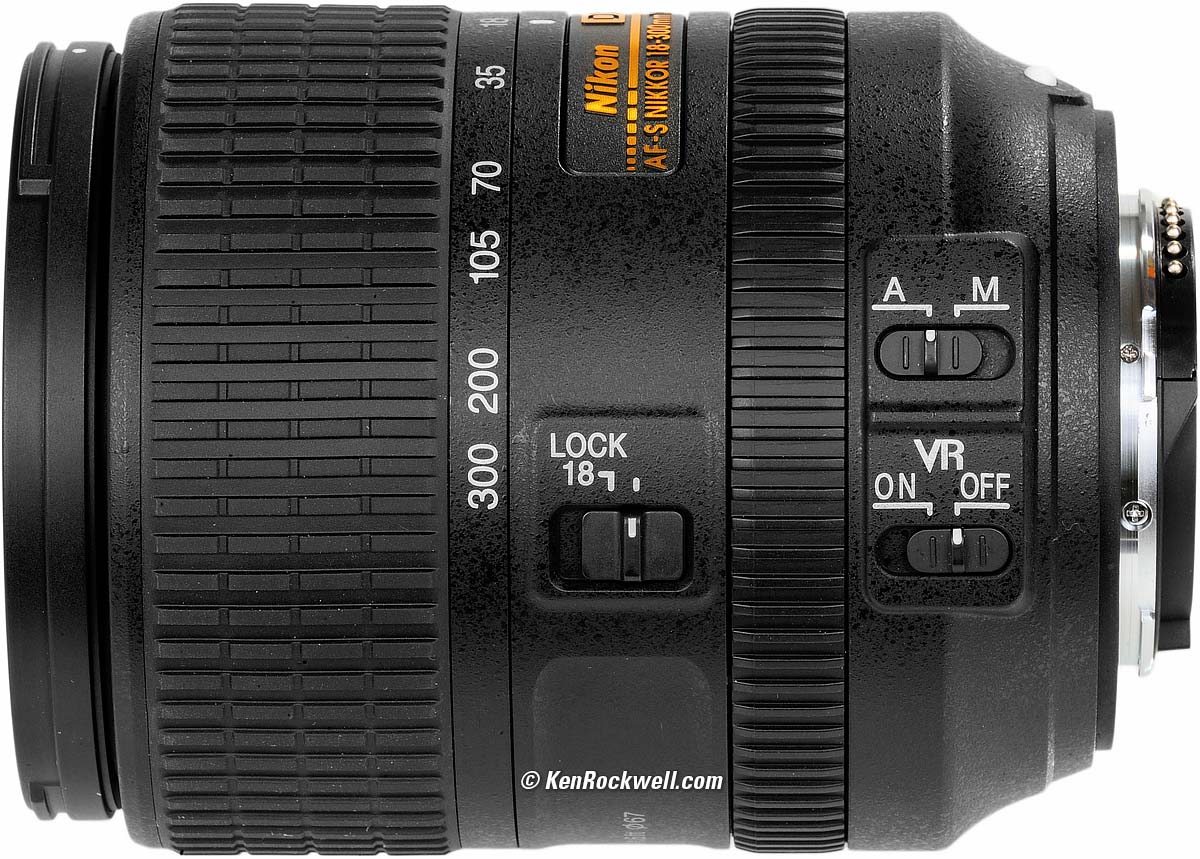Home Donate New Search Gallery Reviews How-To Books Links Workshops About Contact
Nikon 18-300mm VR
f/3.5-6.3 DX AF-S G ED
Intro Specs Performance Usage Compared Recommendations More
Nikon 18-300mm VR (DX only, 67mm filters, 19.4 oz./550g, 1.6'/0.5m close focus, 0.29× macro ratio, $697 new or about $400 used). bigger. I got mine at Adorama. I'd also get it at Amazon, at B&H, at Crutchfield, or get it used if you know How to Win at eBay.
My biggest source of support for this free website is when you use those or any of these links to approved sources when you get anything, regardless of the country in which you live. It helps me keep adding to this free website when you get your things through these approved sources — but I receive nothing for my efforts if you take the risks of buying elsewhere. Thanks for your support! Ken.
November 2022 Nikon Reviews Nikon Lenses Nikon Flash All Reviews
Older version 18-300mm f/3.5-5.6 VR review.
Sample Image File
Dirty Rug. Nikon D7100, 22mm at f/11 at 1/13 hand-held with VR. Full 24 MP Resolution.
Not bad for a hand-held shot at 1/13 of a second. The VR system is spectacular!
Introduction top
Intro Specs Performance Usage Compared Recommendations More
|
|
This Nikon 18-300mm VR is a smaller, lighter version of the original 18-300mm VR. The original 18-300 was very good, so good in fact that I sold an image I made with it to McDonald's — and they are using it on a billboard.
This new lens is as good, and is smaller, lighter and less expensive, so it's even better!
My only real complaint about the original 18-300 was that it weighed a lot more than my camera, and this new 18-300 weighs ten ounces less!
This new 18-300mm also offers Vibration Reduction (4 stops) and instant manual-focus override.
It's very slightly slower at the 300mm end (f/6.3 versus f/5.6) than the older lens, and for ten ounces off my shoulder, that's nothing. By taking off 10 ounces, I now can carry this new lens everywhere I never bothered with the old 18-300.
This new lens do everything, and it even does macro. At 300mm, it focuses to within just inches of the front of the lens.
I got my 18-300 at Adorama. I'd also get it at Amazon, at B&H, at Crutchfield, or get it used if you know How to Win at eBay.
This lens works only on Nikon DX cameras.
Yes, it will shoot on FX cameras, but the corners will always be cut-off. Nikon offers a trick "crop" mode in their FX cameras as a sales incentive to remove the dark corners and only use the middle of the sensor, but you throw away more than half an FX camera's resolution, and have to peep through a small cut-out in the center of the viewfinder.
Nikon offers the DX crop mode on FX cameras more as a trick to get people to buy Nikon FX cameras, thinking that they'll be able to use their existing DX lenses. When people do, they quickly discover that the crop mode is a crock, and wind up buying all new FX lenses anyway. Nikon does this to make it seem like it's less expensive to stay with Nikon than to change to Canon when stepping-up to full-frame, and this trick works for Nikon.
If you see FX in your future, don't be buying a lot of DX lenses.
Nikon 18-300mm VR. bigger
Nikon 18-300mm VR zoomed out to 300mm. bigger.
Specifications top
Intro Specs Performance Usage Compared Recommendations More
I got my 18-300 at Adorama. I'd also get it at Amazon, at B&H, at Crutchfield, or get it used if you know How to Win at eBay.
Name top
Nikon 18-300mm VR. bigger.
Nikon calls this the Nikon AF-S DX NIKKOR 18-300mm f/3.5-6.3G ED VR.
AF-S and SWM: Silent Wave Autofocus Motor.
DX: Won't work well on film or FX cameras.
NIKKOR: Nikon's brand name for all their lenses.
G: Gelded for cost-reduction and removing compatibility with older cameras.
ED: Magic Extra-low Dispersion Glass.
VR: Vibration Reduction. Claims almost 4 stops improvement.
IF: Internal focusing; nothing moves externally as focused.
Aspherical: Specially curved glass to give even sharper pictures.
∅67: 67mm filter thread.
Optics top
Internal Construction. ED and Aspherical elements.
16 elements in 12 groups.
3 ED glass elements.
3 Aspherical elements.
Rated MTF top
Diaphragm top
Nikon 18-300mm VR. bigger.
7 rounded blades.
Stops down to f/22-40.
Coverage top
DX only.
Focal Length top
18-300mm.
When used on a DX camera, it gives angles of view similar to what a 28-450mm lens gives when used on an FX or 35mm camera.
Angle of View top
76° ~ 5.3° on DX.
Close Focus top
1.6 feet (0.48m) from the image plane.
Since the lens sticks out so much, especially at 300mm, it focuses to within a few inches of the front of the lens.
Maximum Reproduction Ratio top
1:3.4 (0.29×).
Hard Infinity Focus Stop? top
No.
You have to let the AF system focus at infinity.
Focus Scale top
No.
Depth-of-Field Scale top
No.
Infra-Red Focus Index top
No.
Aperture Ring top
No.
Filter Thread top
67mm, plastic.
Does not rotate, but pumps in and out with zoom.
Vibration Reduction (VR) top
Claims 4 stops improvement.
Size top
Nikon specifies 3.1" (78.5 mm) diameter by 3.9" (99 mm) extension from flange.
It gets longer as zoomed longer.
Weight top
19.380 oz. (549.4 g), actual measured.
Nikon specifies 19.4 oz. (550g).
Included top
Snap-on LC-67 front lens cap.
LF-4 rear cap.
No hood or case.
Nikon Product Number top
2216.
Warranty top
5 years, USA.
Announced top
12:02 AM, 10 April 2014, New York City Time.
Promised for top
May 2014.
Available Since top
May 2014.
Price, USA top
$697 new or about $400 used if you know How to Win at eBay, November 2022.
$627 new or about $425 used if you know How to Win at eBay, May 2020.
$697, March 2019.
$597, November 2018.
$697, March 2018.
$900, April 2014 ~ September 2015.
Here's the box in 2014. As of 2020 Nikon no longer offers the 5 year warranty:
Nikon 18-300mm VR. bigger.
Performance top
Intro Specs Performance Usage Compared Recommendations More
Overall Autofocus Bokeh Color Coma
Distortion Ergonomics Eyeblow Falloff Filters
Focal Lengths, effective Focus Breathing Full-Frame
Ghosts Lateral Color Fringes Macro Maximum Aperture
Mechanics Sharpness Sunstars Survivability VR
I got my 18-300 at Adorama. I'd also get it at Amazon, at B&H, at Crutchfield, or get it used if you know How to Win at eBay.
Overall performance top
The Nikon 18-300mm f/3.5-6.3 VR is the little lens that can do just about everything. It's only optical weak point is some occasionally strong distortion, but Nikon's latest cameras can correct for it, so no big deal.
Autofocus performance top
Overall
AF is fast and accurate.
AF Speed
AF is fast at the long end, and just as fast at the wide end.
This means it's fast at the long end and fast enough at the wide end, but not as fast at the wide end as some shorter-range zooms.
Manual Focus
Manual focus is great at the long end, but at the wide end you may feel as if you've got to turn the ring too far to get what seems like very little change. This is what happens when a lens has to cover such a huge zoom range.
Bokeh performance top
Bokeh, the character of out of focus backgrounds, not simply how far out of focus they are, is pretty good.
Bokeh of course varies wildly depending on zoom setting, aperture and focus distance.
From 18-50mm bokeh usually isn't particularly visible because depth of field is so great at the wider settings at the slow speeds of this lens. If you can se any bokeh, it can be ratty at the wider settings, but that's not important.
What is important is that bokeh is very good at 100mm and longer.
To get the softest backgrounds, shoot at 300mm and f/6.3.
Color Rendition performance top
The color rendition is the same as my other Nikkor AF lenses.
Coma performance top
Coma (saggital coma flare) often causes weird smeared blobs to appear around bright points of light in the corners of fast or wide lenses at large apertures. In lenses that have it, coma goes away as stopped down.
I can't see any coma.
Distortion performance top
The Nikon 18-300mm f/3.5-6.3 VR is loaded with strong distortion, but that can be OK since most newer DSLRs can correct this automatically
At 18mm the 18-300 has strong barrel distortion, and from 35-300mm has strong pincushion distortion, but recent digital cameras like the D90, D3100, D3200, D3300, D5000, D5100, D5200, D5300, D7000, D7100, D4, D4s, D600, D610, D800, D800E and Df can be set to correct the distortion automatically in-camera — so long as you have the latest camera firmware installed in your camera!
In-camera correction only works if you have firmware at least as new as this lens' introduction (May 2014) loaded in your camera.
Even at its worst, it's easy to correct fully with Photoshop's lens distortion filter. with the factors below. These aren't facts or specifications, they are the results of my research that requires hours of photography and calculations on the resulting data.
Correction factor with uncorrected images |
|
|
18mm |
+4.5 |
+6.0 |
35mm |
-5.5 |
-4.5 |
70mm |
-4.5 |
-4.0 |
105mm |
-3.5 |
-3.5 |
200mm |
-2.5 |
-2.5 |
300mm |
-1.5 |
0.0 |
© 2014 KenRockwell.com. All rights reserved.
Ergonomics (handling and ease-of-use) performance top
Nikon 18-300mm f/3.5-6.3 VR. bigger.
Ergonomics are fantastic.
The front half of the lens is the zoom ring; grab and go.
Zooming is very well spread out. It's easy to select a precise cropping, and it's also easy to zoom all the way from one end to the other. Magnificent!
Manual focus is also easy: just flick the rear focus ring with a fingertip. The only gothca is that the ring takes a lot of turning at the wide end; it's done this way so we have enough precision at the 300mm end.
Eyeblow performance top
As the 18-300mm f/3.5-6.3 VR is zoomed in and out, air pumps in and out, and you may have some air blow out of the eyepiece into your eye.
No air comes out the eyepiece of my D7100, but the design of the 18-300mm f/3.5-6.3 VR is such that air, and thus dirt, are pumped in and out all the time into both your lens and your camera.
Falloff (darkened corners) performance top
This lens doesn't work on FX and 35mm; the four corners are all completely cut off.
Falloff on DX is minor , and most cameras will correct for this automatically. If you're shooting with a camera that can't correct this, the on;y time you might see it is at the longest end shot wide-open at the sky or at 18mm wide open, otherwise it's all invisible.
I've exaggerated this by shooting a gray field and placing these on a gray background:
Nikon 18-300mm f/3.5-6.3 VR falloff on DX at infinity, no correction.
© 2014 KenRockwell.com. All rights reserved.
|
Filters, use with performance top
There is no problem with vignetting, even two stacked filters. With two stacked filters I only started to see the slightest vignetting at 18mm, and none as zoomed in. No need for expensive thin filters here!
The filter ring doesn't rotate, but does move in and out with zooming.
Focal Lengths, actual performance top
The effective maximum focal length shortens at distances closer than infinity in order to allow this lens to focus as close as it does.
At infinity where you need it, it really goes to 300mm, while at closer distances (50 feet and closer) the 300mm position isn't really the same as a dedicated 300mm lens.
At 1.6 feet, this 18-300mm may really only be much less than 300mm. This is deliberate because Nikon is playing an optical trick of reducing the effective focal length in exchange for letting us focus so ridiculously close. It's supposed to be this way, otherwise this lens wouldn't focus any closer than 8 feet (2.5 meters) like other 300mm lenses.
Focus Breathing performance top
Of interest mostly to cinematographers focusing back and forth between two subjects, the image from the Nikon 18-300mm f/3.5-6.3 VR gets smaller as focused more closely.
Full Frame, use on performance top
Forget it.
The four corners are always completely black at every focal length.
Ghosts performance top
Shot directly into the noontime sun at f/11, with a UV filter over the lens! bigger.
There's no problem with flare or ghosts.
Even shot directly into the sun and putting a tree in the bottom of the shot to highlight any ghosts that might materialize, there's nothing significant.
In actual use, there will be none.
This is excellent performance.
Lateral Color Fringes performance top
There are no lateral color fringes on the D7100, which corrects them automatically.
The only fringes I saw were at 300mm in the D7100, where I could see some blue-yellow fringes.
I saw none as shot on a D2HS, which can't correct these, but I wasn't looking as hard or shooting at 300mm.
Macro performance top
Macro performance is great.
The 18-300mm gets super-close, and it's also super sharp, even wide open.
GPW Watch. 18-300mm at 300mm at close-focus distance wide-open at f/6.3. bigger or camera-original © file.
Crop from above 24 MP image at 100%. bigger or camera-original © file.
If this crop is about 6" (15cm) wide on your screen, then the complete image printed at this same extreme magnification would be about 20 × 30" (50 × 75cm). If this crop is about 12" (30cm) wide on your screen, then the complete image printed at this same extreme magnification would be about 40 × 60" (1 × 1.5 meters)!
In the crop above, the rough face of the watch is sharp and in focus, even wide open here. The hands and the date inside the window are closer or further away than the watch face, and therefore they are not in focus and are softer. That's no defect of the lens, this is optics: only one vapor-thin plan is ever in focus at macro distances and you have to plan your subjects accordingly, or stop down.
Maximum and Minimum Apertures performance top
Maximum |
Minimum |
|
18mm |
f/3.5 |
f/22 |
35mm |
f/4.2 |
f/29 |
70mm |
f/5 |
f/32 |
105mm |
f/5.6 |
f/36 |
200mm |
f/6.3 |
f/40 |
300mm |
f/6.3 |
f/40 |
Mechanics and Construction performance top
Nikon 18-300mm f/3.5-6.3 VR. bigger.
The Nikon 18-300mm f/3.5-6.3 VR is made about the same as Nikon's most expensive lenses today: all plastic except for the metal lens mount.
Filter Threads
Plastic.
Hood Mount
Plastic.
Front Barrel
Plastic.
Second Barrel (between zoom ring and front barrel, only visible when zoomed to longer settings)
Metal.
Zoom Ring
Plastic; rubber covered.
Mid Barrel (between focus and zoom rings)
Plastic.
Focus Ring
Rubbery plastic.
Rear Barrel (between mount and focus ring)
Plastic.
Focus Scale
None.
Depth of Field Scale
None.
Internals
Mostly plastic.
Aperture Ring
None.
Mount
Dull-chromed brass.
Markings
Paint.
Mounting Index Dot
White plastic ball.
Identity Plate
Gold-look plastic.
Serial Number
Sticker glued into a recess on the bottom of the lens.
US Model Signified by
"US" prefix to serial number.
Dust seal at mount
Yes.
Noises When Shaken
Nearly no clicking.
Made in
China.
Weaknesses
Don't drop this on the front or you may crack the zoom cylinders or cam followers
Sharpness performance top
The Nikon 18-300mm f/3.5-6.3 VR is more than sharp enough for all the purposes to which it will be put.
Image sharpness depends more on you than your lens and lens sharpness doesn't mean much to good photographers anyway.
Sure, if you're more interested in photographing test patterns and compare it at its 300mm setting to the $6,000 300mm f/2.8 VR II and look at the results actually printed eight feet wide and then look way out into the far corners you might see some difference, but for actual photographs that matter — or at shorter focal lengths — you won't see any differences. It's super-sharp.
It's always very sharp in the center. In the laboratory I can see slightly less sharpness at extreme settings at the sides and corners if I go out of my way to put details there, but we don't put the central parts of our pictures in the corners. Stopped down at normal apertures it's also very sharp out to the corners.
Hint: I always increase the sharpening setting in my Nikon's Picture Controls.
As I said at the top, I had no problem selling an image I shot with the older Version 18-300mm VR to McDonald's, and it looks great on the billboards on which it is displayed as I write this review. I wouldn't worry about what people with no professional portfolio or qualifications might say about this lens; successful photographers don't work in camera stores or have the time to publish reviews on YouBoob.
Sunstars performance top
With its relatively rounded diaphragm, this 18-300 makes no sunstars on brilliant points of light. Rats!
Survivability performance top
The Nikon 18-300mm f/3.5-6.3 VR is mostly plastic. Don't hit the front of it or you may jam the zoom mechanism.
It depends on proprietary Nikon parts for the autofocus motor and VR system. If any of these break in the far future, you'll lose autofocus or VR if Nikon no longer has parts.
I wouldn't worry about it; with a 5-year USA warranty. Nikon stands behind its products, and I've never had any of my plastic Nikon lenses ever break; it's always been my tough metal pro lenses that have problems!
Vibration Reduction performance top
The Vibration Reduction (VR or Image Stabilization) system is superb.
At 300mm, I get perfectly sharp images hand-held at 1/8 second most of the time, and even at 1/4 second I get a perfectly sharp shot every few shots. At 1/4 second I fire a few shots to be sure I get one that's perfectly sharp.
This is superb. Of course you have to be good at shooting a rifle to do this; hold still and s-q-u-e-e-z-e the trigger s-l-o-w-l-y. I don't know how slow you can shoot it if you jerk the shutter button.
Usage top
Intro Specs Performance Usage Compared Recommendations More
I got my 18-300 at Adorama. I'd also get it at Amazon, at B&H, at Crutchfield, or get it used if you know How to Win at eBay.
A - M
Nikon 18-300mm VR. bigger.
A - M means autofocus or manual focus.
Leave your camera set to AF and leave this switch at A.
If you need manual focus, just move the focus ring; no switch movement needed.
If you want to lock the lens in manual focus mode, slide the switch to M and leave your camera set to AF.
VR
Leave VR ON.
Even on a tripod, VR still helps overcome tripod wiggle.
I'd turn VR off for time exposures on a tripod, and leave it on for all normal shooting.
Compared top
Intro Specs Performance Usage Compared Recommendations More
I got my 18-300 at Adorama. I'd also get it at Amazon, at B&H, at Crutchfield, or get it used if you know How to Win at eBay.
Versus the old 18-300mm
The original 18-300 VR is much bigger and heavier, and more expensive. I'd forget about it. It adds a focus distance scale, and that's about its only benefit. This new lens is less expensive, smaller and lighter, while the old lens is a big heavy beast you'll not want to carry everywhere around your neck.
Versus the 18-200mm VR
The 18-200 VR DX is about the same size and weight, but only goes to 200mm. It's an older lens.
Versus the 28-300mm FX
The 28-300mm VR lens is much bigger and heavier and only goes to 28mm. Don't use it on DX; it's designed for FX, so it's much bigger and heaver to cover the larger FX format. Forget it for use with DX cameras.
Versus the 18-55 and 55-300 Combo
This Nikon 18-300mm VR replaces the combination of 18-55mm VR II and 55-300mm VR lenses in one lens.
This one-lens 18-300mm VR solution weighs less than both other lenses combined, and eliminates the need to change lenses — but it costs more than both those lenses combined. Heck, this 18-300 weighs less than the 55-300mm alone!
This 18-300 has faster autofocus and instant manual-focus override,both missing in the 55-300mm VR, so this 18-300mm is also much better for sports than the dedicated 55-300mm.
If you prefer shooting test charts, the 18-55 and 55-300 can be a little sharper than this 18-300mm, but I'm not going to worry about it. I prefer the one-lens 18-300mm VR over having to lug two lenses with me and swap them all the time.
Recommendations top
Intro Specs Performance Usage Compared Recommendations More
I got my 18-300 at Adorama. I'd also get it at Amazon, at B&H, at Crutchfield, or get it used if you know How to Win at eBay.
This Nikon 18-300mm is the new freedom lens. It does everything you'd ever need, from family to landscapes to portraits to sports to African safaris. This 18-300mm does it all. The only thing it doesn't do is have high optical speed for use in the dark without flash; for that one thing I love my inexpensive and excellent 35/1.8 DX.
Don't use this 18-300 on FX and 35mm cameras. It will never fill the frame on 35mm, and you'll only be using the small central area of the FX frame and viewfinder. For FX and 35mm, use the 28-300 VR.
For DX cameras, this lens is an easy recommendation. There is nothing on Earth like this lens. Nothing else covers this huge range with VR and instant manual-focus override in a lens this small and light. This is the one lens you take with you when you hit the road and don't know what you'll see.
Cheap brands like Tamron usually offer cheap copies, sometimes with even broader zoom ranges, but they usually lack full-time manual focus override or good VR, and certainly lack the mechanical quality and future serviceability and repairability we take for granted with Nikon. I'd never buy a Tamron or Sigma lens; they are mostly come-ons sold to unwitting newcomers at retail stores and lack the basic internal quality and long-term serviceability of Canon, Nikon and LEICA lenses.
Not only is it small and light and extremely flexible, I was able to sell an image to McDonald's for a billboard using the older model. If you know what you're doing, you'll get spectacular results from this lens. If you don't, no lens is going to give you great images — you have to earn them. This lens packs more abilities into less space than any other lens, so get one and take advantage of it.
If you've found my research helpful, my biggest source of support for this all-content, junk-free website is when you use any of these links to get yours at Adorama, at Amazon, at B&H, at Crutchfield, or get it used at eBay. Using those or any of these links to approved sources when you get anything, regardless of the country in which you live helps me keep adding to this free website when you get your things through those links or these approved sources — but I receive nothing for my efforts if you take the risks of buying elsewhere.
Thanks for your support!
Ken.
Deployment
I rarely use front lens caps. Instead, I'd leave either a $57 67mm Nikon Clear (NC - UV) filter, or a $28 67mm Hoya Multicoated UV on the lens at all times. Many people prefer the German $30 B+W 67mm 010 UV or $55 B+W 67mm 010M multicoated UV filters. All of these are excellent; pick any favorite brand.
If I was working in nasty, dirty areas, I'd use a fingerprint-proof and bulletproof $100 67mm Hoya HD2 UV filter, or a $6 uncoated 67mm Tiffen UV filter instead. Uncoated filters like the are much easier to clean, but more prone to ghosting, while the Hoya is so advanced that it's coating resists most dirt in the first place.
More Information top
Intro Specs Performance Usage Compared Recommendations More
Nikon's 18-300mm Press Release.
© Ken Rockwell. All rights reserved. Tous droits réservés. Alle Rechte vorbehalten.
Help me help you top
I support my growing family through this website, as crazy as it might seem.
The biggest help is when you use any of these links when you get anything, regardless of the country in which you live. It costs you nothing, and is this site's, and thus my family's, biggest source of support. These places have the best prices and service, which is why I've used them since before this website existed. I recommend them all personally.
If you find this page as helpful as a book you might have had to buy or a workshop you may have had to take, feel free to help me continue helping everyone.
If you've gotten your gear through one of my links or helped otherwise, you're family. It's great people like you who allow me to keep adding to this site full-time. Thanks!
If you haven't helped yet, please do, and consider helping me with a gift of $5.00.
As this page is copyrighted and formally registered, it is unlawful to make copies, especially in the form of printouts for personal use. If you wish to make a printout for personal use, you are granted one-time permission only if you PayPal me $5.00 per printout or part thereof. Thank you!
Thanks for reading!
Mr. & Mrs. Ken Rockwell, Ryan and Katie.
Home Donate New Search Gallery Reviews How-To Books Links Workshops About Contact
